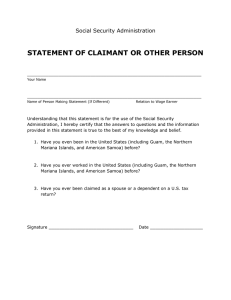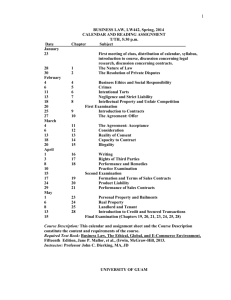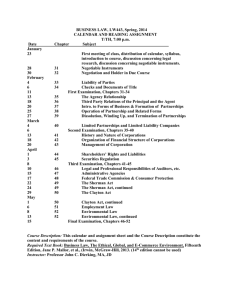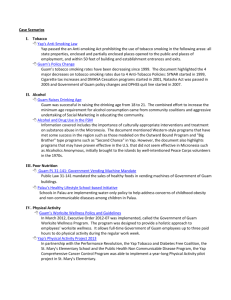Report of a consultation: Pacific Public Health Laboratory Review Guam
advertisement
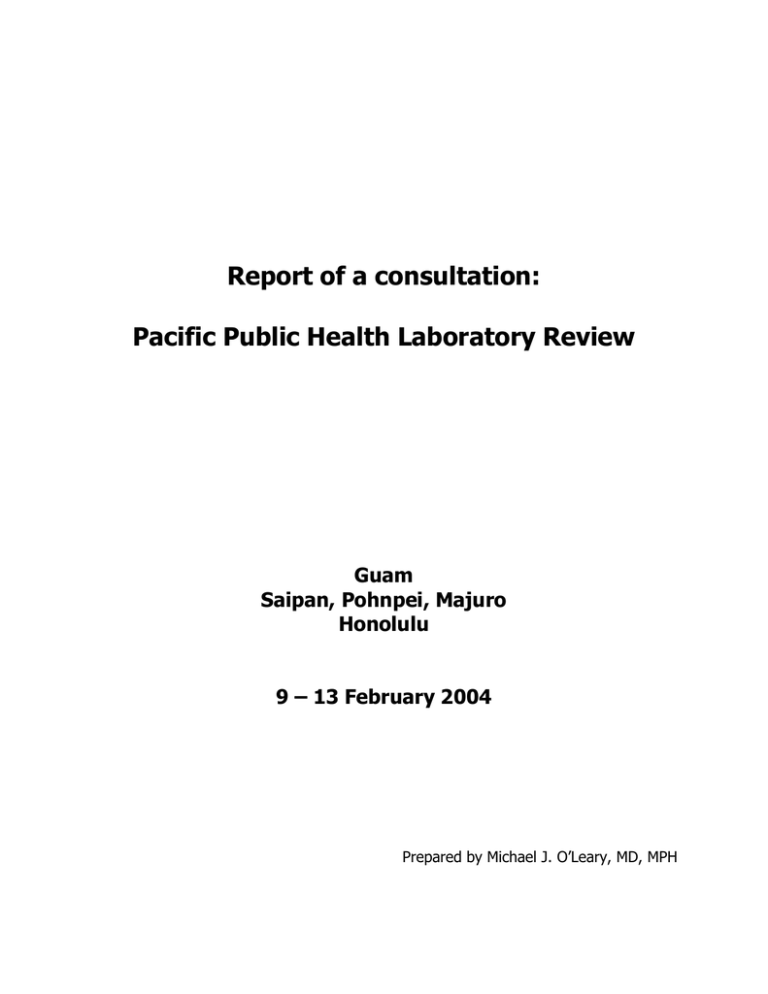
Report of a consultation: Pacific Public Health Laboratory Review Guam Saipan, Pohnpei, Majuro Honolulu 9 – 13 February 2004 Prepared by Michael J. O’Leary, MD, MPH Table of contents 1. Background ………………………………………………………….. 2 2. Objectives ……………………………………………………………. 2 3. Agenda and itinerary …………………………………………….. 3 4. Proceedings …………………………………………………………. 3 a. Guam 3 b. Saipan, Pohnpei, Majuro 4 c. Honolulu 4 5. Conclusions and recommendations …………………………. 5 a. Regional laboratory infrastructure 5 b. Scope of services 5 c. Equipment 6 d. Supplies and sustainable funding 6 e. Training 6 f. Quality assurance 7 g. Communications 7 h. Regional oversight: RLAB 7 6. Next steps ……………………………………………………………… 8 Annex A – List of participants ………………………….. 9 Annex B – Agenda …………………………………………. 11 Annex C – Materials available ………………………….. 13 1 Report of a consultation Pacific Public Health Laboratory Review 9 – 13 February 2004 1. Background Draft 20 Feb 04 In order to establish more formal arrangements for regional public health laboratory services in the six American-affiliated Pacific island (AAPI) countries and territories*, a consultation was held in several Pacific laboratory sites from 9 to 13 February 2004. This consultation built on a LabNet initiative of the Pacific Public Health Surveillance Network (PPHSN), on joint efforts between Pacific jurisdictions and CDC categorical programs (e.g. HIV, tuberculosis, STDs, immunization program), and on individual efforts of public health and laboratory staff in the AAPI. The consultation arose directly from a consensus decision among the Board of Directors of the Pacific Island Health Officers Association (PIHOA), which includes the directors and heads of health of the six AAPI. In February 2003, PIHOA had identified as a priority, the availability of regional laboratory services for selected public health conditions. A proposal for collaborative action was endorsed by PIHOA members during 2003 and each contributed funds for initial activities through bioterrorism cooperative agreements with CDC. This review consultation was the first activity funded through these cooperative agreements, with additional financial contributions from the Hawaii Department of Health, the World Health Organization using funds sourced from the Global Fund to Fight AIDS, Tuberculosis, and Malaria (GFATM), and CDC. * AAPI: Flag territories: American Samoa, Guam, Commonwealth of the Northern Mariana Islands Freely-associated states: Federated States of Micronesia, Republic of the Marshall Islands, Republic of Palau 2. Objectives The objectives of the review were: to assess current capacities (equipment, tests performed) at L1 (primary hospital) and L2 (regional public health) laboratories for target conditions (measles, rubella, dengue, leptospirosis, influenza, SARS, cholera, typhoid). to define the scope of work at all laboratory levels: o which public health lab tests are or will be made available at which level or laboratory; o what is the expected volume of tests to be done at each level; and o what is the basic minimum clinical diagnostic capability expected at L1 labs to conduct a needs assessment for each lab to meet these expectations, considering the need for new equipment, additional staff, a sustainable delivery system for test kits and other consumables, and sustainable laboratory support. to conduct a training needs assessment. to develop draft Memoranda of Understanding among the laboratories concerned. 2 3. Agenda and itinerary The review started with a meeting at the Guam Department of Public Health and Social Services on 9–10 February 2004. Several of the participants traveled to either Saipan, Pohnpei, or Majuro on 11–12 February to review the laboratory capacity and situation at those sites. The review concluded with a meeting at the Hawaii Department of Health Laboratory on 13 February. A complete list of participants, including sites visited, is attached as Annex A, and the initial agenda is attached as Annex B. 4. Proceedings a. Guam The Guam meeting was opened by Mr PeterJohn Camacho, the Guam Director of Public Health and Social Services. Participants endorsed Mr Albert Gurusamy as the meeting chairman, and Dr Alain Berlioz-Arthaud as the rapporteur. The presentations are listed in the agenda, Annex B, and may be summarized as: a review of the history of regional laboratory development (PPHSN, LabNet, previous initiatives in the AAPI); a review of current laboratory capacities, volume of testing for target conditions, and sources of support; a discussion of future options for L1 and L2 testing, financing, and support; a review of the current status and future needs for quality assurance and for training. Some principal findings and outcomes of the discussions included: Strengths identified Political will among PIHOA directors Good technical expertise in Guam An established QA mechanism through PPTC, which could expand Current and potential financial support – bioterrorism funds, GFATM, etc. Some identified needs/ problems Training (many L1 staff have only on-the-job training) Shortage of staff in Guam Supplies (sometimes run out, slow to receive new supplies, over-extended credit) Shipping logistics and funds CLIA and FDA requirements in flag territories Hawaii funds are not normally for regional use Communications among laboratories not well-established; need for secure data transmission 3 Some identified solutions - Staffing, funding, supplies “Regional” lab supervisor and lab staff Revolving/ reimbursable fund Prospect for more BT funding in Guam since Guam is the only Level B lab, and has a regional responsibility New sources of funding – e.g. Epidemiology and Laboratory Capacity Cooperative Agreements with CDC Borrow test kits from other labs when needed Contract with DLS or other private lab for some services Some identified solutions - Training/ technical support Training proposal from Palau Distance learning External support from LabNet Further technical support from California (e.g. CLIA, web-based reporting, training) Other reference support already established for selected aspects through California and Hawaii laboratories, Institut Pasteur New Caledonia (IPNC), selected Australia and New Zealand laboratories b. Saipan, Pohnpei, Majuro The two-day concurrent visits to Saipan, Majuro, and Pohnpei allowed many participants to review current services and capacities, and future needs in these laboratories. The objectives of the visits were to review: current capacities and needs for target conditions; expectations for local testing for target conditions; resource and training needs; requirements to establish referral linkages. The reports of the visiting teams are available electronically on request, as are most presentations made during this consultation, from PIHOA (pihoa@hawaii.edu) or from Dr Michael O’Leary (mjoleary@guam.net) (see Annex C). c. Honolulu The Honolulu wrap-up meeting was opened by Dr Jane Kadohiro, the Deputy Director of Health, State of Hawaii, and by Dr Vernon Miyamoto, the director of the State Laboratories Division. The list of presentations is again provided in the agenda, Annex B, and included a review of the Guam meeting and the findings of the site visits, presentations by the representatives from Majuro and American Samoa, and an overview and tour of the Hawaii public health laboratory. Much of the time was taken up in discussion of the key issues identified during the consultation and laboratory visits, and proposed solutions or recommendations for moving forward. 4 5. Conclusions and recommendations Participants achieved a consensus on the following key points: a. Regional laboratory infrastructure It was agreed that Guam Public Health Laboratory is geographically well-located, has welltrained staff and sufficient technical equipment and experience to perform most of the desired L2 tests. However it is currently inadequately staffed to perform regional functions. Also, such a regional role will require strong technical supervision, management, and communications. For Guam to fulfill a regional role at present would probably require an additional laboratory technician or technologist, and a technical supervisor or regional coordinator. Funding for such posts could be solicited from the AAPI as regional staff, perhaps employed directly by PIHOA. A clear job description would be necessary to ensure smooth integration into the existing Government of Guam structure and staffing. An alternative or additional consideration would be to “regionalize” some specific testing at other laboratories, e.g. Saipan, Pohnpei, or Palau. Such alternatives would need to be seriously considered should supervision, staffing, or management issues not be resolvable for regional purposes in Guam. A special effort will be required to ensure similar laboratory services for American Samoa. Given the geographic realities, American Samoa will not have adequate access to services provided in Guam. In addition, American Samoa has remaining issues in specimen transport with its air carriers, which are similar to those of the Micronesian countries but involve different airlines. b. Scope of services Although there are details of testing yet to be discussed and agreed (and these must remain flexible in any case), participants generally endorsed the “possible scope of work” as presented during the meeting. The current target conditions were confirmed to be the agents of bioterrorism, tuberculosis, HIV, sexually transmitted diseases, and epidemic-prone diseases including measles, rubella, dengue, leptospirosis, influenza, SARS, cholera, and typhoid. The valuable role of Pacific rim laboratories was well-recognized in providing reference support, or in some cases, direct support to island laboratories. These include both the California and Hawaii state laboratory systems (in Richmond and Honolulu), especially for tuberculosis testing, agents of bioterrorism, and SARS, and the reference laboratories in New Caledonia, Australia, and New Zealand which are voluntary partners in LabNet. Examples (preliminary list) of the tests which might be regionally available through, for example, the Guam Public Health Laboratory include: Bioterrorism agents HIV Tuberculosis STD Measles/ rubella Dengue Leptospirosis Influenza Cholera/ typhoid Level B testing for anthrax, plague, tularemia EIA and Western blot Culture and susceptibility testing Confirmatory syphilis testing (e.g. TP-PA) EIA IgM Rapid tests and EIA IgM Rapid tests and EIA IgM Directigen A+B or similar Confirmation and susceptibility testing 5 c. Equipment The Guam Public Health Laboratory is fairly well-equipped to provide regional services, although a number of desired equipment items have been identified. These need to be prioritized. There is already a small provision in the PIHOA regional laboratory budget for equipment (i.e., costshared among the AAPI), and the PIHOA jurisdictions could be approached to share additional necessary items, perhaps in the next budget cycle. A specific issue addressed during the consultation was the widespread introduction of Level II biosafety cabinets, without adequate provision for inspection and maintenance. In many laboratories, Level I cabinets would be adequate to the needs, require less maintenance, and thus be safer (and cheaper) for longterm use. Overall, decisions on “regional” equipment may be made jointly by the participating laboratories and costs shared, and information may be shared among laboratories regarding new equipment purchase at local level. This would allow more standardization in equipment across the AAPI, potentially reducing maintenance and supply costs through bulk purchasing and sharing of services. It was also agreed that biosafety cabinet inspection and maintenance lent itself to a regional approach, and should be incorporated in this initiative. d. Supplies and sustainable funding Participants agreed with the principle that individual jurisdictions should be responsible for purchase of supplies or cost reimbursement for testing done on their behalf at regional level. This includes test kits, certain consumables, shipping supplies, and shipping costs. Because of the difficulties and delays in obtaining timely funding at national level, there was consensus agreement with the use of a revolving, or reimbursable fund for this purpose. Such a fund has already been initially capitalized by PIHOA members, and preliminary guidelines for use drafted. This fund could be tapped by any participating jurisdiction for rapid access to funds for the above purposes, with the understanding that each jurisdiction would replenish the fund annually to the extent used. Some items may be pre-purchased through the fund (with agreement of the contributors), where very rapid access is necessary. For example, a small stockpile of shipping supplies may be held in reserve; or one measles test kit may be kept “on the shelf” at all times in Guam, ready for rapid use if needed. Financial contributions to regional testing, as above, must be seen as a responsibility of each jurisdiction. This obligation may be met through the national health budget mechanism, or where possible and appropriate, through donor support, or through allocation to regional use of portions of national cooperative agreements with CDC (e.g. bioterrorism). e. Training Two essential aspects of training were considered: continuing education for laboratory staff, and academic qualifications for both existing and new staff. While training needs are reasonably well-understood, there is a need to integrate the various initiatives to meet these needs. For continuing education these include (at least) the existing or proposed training programs of the Pacific Paramedical Training Centre (PPTC), the Pacific Association for Clinical Training (PACT), the Fiji School of Medicine, and the World Health Organization. For academic credentials 6 (important to many staff for career development) there are the long-standing residential degree laboratory programs at the Fiji School of Medicine (FSMed), and the newly-developing initiative among the Palau AHEC (Area Health Education Center), PPTC, and the FSMed, to be initially based in Palau. One role of any “regional” laboratory staff or advisory board would be to ensure that an overall training plan were developed to meet the needs of the jurisdictions, drawing on the resources available in the most efficient and effective manner. One resource for training materials is the National Laboratory Training Network, http://www.phppo.cdc.gov/nltn/default.aspx. f. Quality assurance PPTC has long facilitated voluntary external quality assurance (QA) in the Pacific, including the three freely-associated states of the AAPI. In addition, the three U.S. flag territories are required by CLIA to maintain certain standards of quality assurance and quality control. It was agreed among participants that, given the importance of QA to standards of laboratory practice, such efforts should continue and be further strengthened. Quality assurance could be a regional effort, and a regional laboratory supervisor or coordinator could play an active role in assuring laboratory participation and compliance, especially among the three freely-associated states. To incorporate this role in the job description of this regional staff person, a travel budget would need to be provided. Visiting laboratories for the purpose of QA would also constitute a site visit for other purposes, e.g. equipment assessments, training, or sorting out technical, logistics and administrative aspects of the regional laboratory services. g. Communications Laboratories in the AAPI are not well-connected for communications purposes. Few laboratory staff have direct e-mail access or Internet access (and even fewer, broadband access). Where e-mail/Internet access is available, it may be suspended due to non-payment of communication bills, which are costly in the Pacific and typically rely on dial-up access (some jurisdictions have better access). To sustain regional services, this situation needs significant improvement. In addition, a secure means of rapidly and confidentially sharing data and results is required. Both of these require equipment, sustainable funding, and ongoing technical support. At the least, each participating laboratory needs a primary point of contact with ready e-mail access. Some equipment purchase may be necessary, and even in some cases funds for ongoing communications access. These could perhaps be incorporated into “regional’ funding. External technical support (e.g. from the California laboratory, or through LabNet) can be provided to incorporate a secure data network into this initiative, for transmitting test results and other data needs. Such support may also be available for day-to-day technical problems in maintaining electronic communications, but local support is generally necessary as well. Fax may be used as an alternative, or a back-up, where necessary. h. Regional oversight: RLAB Participants agreed that success of this initiative will require external oversight and guidance, both in the short term to finalize details of the above recommendations, and in an ongoing capacity to allow collective decision-making and guidance to the collaborating laboratories. It 7 was agreed in principle to establish a Regional Laboratory Advisory Board (RLAB) to (example terms of reference): oversee the initial and ongoing arrangements and technical aspects of a regional collaboration for public health laboratory services; propose staffing and equipment needs; oversee the use of a reimbursable fund; propose, conduct, or ensure coordination of local and overseas continuing education and credentialed laboratory training; pursue a regionally-coordinated quality assurance mechanism, building on existing programs; and ensure ongoing representative RLAB membership. In the short term, the RLAB would also deliver a more detailed proposal to the PIHOA Board of Directors at its next meeting. In the short-term, the following participants in this review agreed to serve on the RLAB: Alain Berlioz-Arthaud, IPNC John Elliot, PPTC Devery Howerton, CDC PHPPO Paul Kimsey, California Department of Health Vernon Miyamoto, Hawaii Department of Health Robert Tucker, PIHOA Michael O’Leary, CDC/NCID, Guam (in a facilitating role) An ongoing RLAB should also include country/ local laboratory representatives, perhaps on a rotating basis. The initial RLAB may consider how to ensure its own membership succession. 6. Next steps (by end of March 2004) 1. Initiate a conference call among members of the Regional Laboratory Advisory Board (RLAB) within two weeks of the conclusion of this consultation, and maintain e-mail and/or conference call communications in the following weeks. 2. Secure a commitment from the Guam Public Health Laboratory for this proposal (or seek another alternative). 3. Prioritize equipment needs in Guam (or elsewhere, if needed). 4. Identify funds and establish a post description for (probably) two regional positions: a technical supervisor or regional coordinator, and a laboratory technologist. 5. Prepare a detailed proposal for regional public health laboratory services, for presentation to the PIHOA Board members at their next meeting (5-9 April 2004). 8 Annex A (page 1 of 2) List of Participants Pacific Regional Public Health Laboratory Review, 9 – 13 February 2004 Participant Address Phone / Fax / e-mail Sites visited Alain Berlioz-Arthaud PASTEUR Institute BP 61, 98845 Noumea New Caledonia W +687 27.02.85 F +687 27.33.90 aberlioz@pasteur.nc Guam Pohnpei Honolulu W 671 735 7283 F 671 734 2066 smdavid@dphss.govguam.net Guam Severino David Health Services Administrator DPHSS, P.O. Box 2816 Hagatna, Guam 96932 David Dawson WHO WPRO P.O. Box 2932 100 Manila, Philippines W +63 2 528 8001 F +63 2 521 1036 dddn@ozconnect.net Guam Saipan John Elliot Pacific Paramedical Training Centre PO Box 7013 Wellington, New Zealand W + 64 4 389 6294 F +64 4 389 6295 pptc@clear.net.nz Guam Majuro Honolulu Albert Gurusamy Medical Laboratory, CHC P.O. Box 500409 Saipan, MP 96950 W 670 236 8395 or 670 234 8950 F 670 236 8612 chclab@dphsaipan.com Guam Saipan CDC, PHPPO, DLS 4770 Buford Hwy, MS G-23 Atlanta, GA 30341-3717 W 770 488 8126; C 404 375 1739 F 770 488 8275 dxh7@cdc.gov Guam Saipan Honolulu Paul Kimsey California Department of Health Services 7227 Pope Valley Road Pope Valley, CA 94567 W 510 307 8419; C 510 812 4571 F 707 965 0618 PKimsey@dhs.ca.gov Guam Majuro Honolulu Linda Kuo Department of Health Services, California lkuo@dhs.ca.gov Guam Saipan Paul Lalita Ministry of Health and Environment P.O. Box 16, Majuro 96960 W +692 625 5660 F +692 625 3432/ 4543 c/o: sals_duit@hotmail.com Majuro Honolulu State of Hawaii, Laboratories Division 2725 Waimano Home Road Pearl City, Hawaii 96782 W 808 453 6652 F 808 453 5562 vkmiyamo@mail.health.state.hi.us Guam Pohnpei Honolulu Michael O’Leary 288 Biradan Anakko Court Dededo, Guam 96929 W 671 637 6704; C 671 888 4869 F 671 734 2066 mjoleary@guam.net Guam Honolulu Paulino Rosario Pohnpei State Dept of Health Services Nett, Pohnpei FSM 96941 W +691 320 2214; or 320 3805 F +691 320 5394 psdhs@mail.fm Guam Pohnpei Emelita Santos Department of Public Health and Social Services (DPHSS), P.O. Box 2816 Hagatna, Guam 96932 W 671 735 7153 F 671 734 2066 c/o: smdavid@dphss.govguam.net Guam Pohnpei Honolulu W +680 488 2552 F +680 488 1310 medlab@palau-health.net Guam Francis Termeteet Ministry of Health, PO Box 6027, Koror Republic of Palau 96940 W +684 633 2001 F +684 633 1200 Honolulu Vasiti Uluiviti Dept of Laboratory Services LBJ Tropical Medical Center Pago Pago, Am Samoa 96799 Devery Howerton Vernon Miyamoto 9 Local or self-sponsored participants Participant Address Annex A (page 2 of 2) Phone / Fax / e-mail Site Guam W 671 735 7101 F 671 734 2066 director@dphss.govguam.net Guam PeterJohn Camacho Director, Guam Department of Public Health and Social Services (DPHSS) P.O. Box 2816, Hagatna, Guam 96932 Cecilia Arciaga TB Program Manager DPHSS, Guam ctarciaga@dphss.govguam.net Guam Nilda Corcino Greg Dever Cynthia Henson Hector Marzo Lea Nisay Josie O’Mallan Glenda Pangelinan Bernie Schumann DPHSS Laboratory, Guam Guam Director, Bureau of Hospital and Clinical Services, Ministry of Health PO Box 6027, Koror, Palau 96940 W 680 488 2813 gdever@palaunet.com Guam Diagnostic Laboratory Services, Inc W 671 646 5770 chenson@dls.queens.org Guam DPHSS Laboratory, Guam Guam DPHSS Laboratory (TB), Guam Guam Administrator Communicable Disease Control DPHSS, Guam jtomallan@dphss.govguam.net Guam Guam Memorial Hospital Laboratory W 671 647 2552 glenda.pangelinan@gmha.org Guam STD Program Manager DPHSS, Guam bpschumann@dphss.govguam.net Guam DPHSS Laboratory, Guam Guam Jane Kadohiro Deputy Director of Health Hawaii Department of Health Honolulu Paul Effler State Epidemiologist Hawaii Department of Health pveffler@mail.health.state.hi.us Honolulu W 808 453 6700 F 808 453 6716 gykunimo@mail.health.state.hi.us Honolulu Gail Kunimoto Medical Microbiology Branch State of Hawaii, Laboratories Division 2725 Waimano Home Road Pearl City, Hawaii 96782 Aileen Kow Tuberculosis Branch State of Hawaii, Laboratories Division Jason Nehal Tuberculosis Branch State of Hawaii Department of Health Rebecca Sciulli Bioterrorism Branch State of Hawaii, Laboratories Division Joy Villanueva Hawaii Robert Tucker Executive Director, PIHOA 1451 So. King Street, Suite 211 Honolulu, Hawaii 96814 Honolulu jnehal@tb.health.state.hi.us Honolulu Honolulu W 808 945 1555 F 808 945 1558 pihoa@hawaii.edu tuckerrv@aol.com Honolulu 10 Annex B (page 1 of 2) Agenda Pacific Regional Public Health Laboratory Review 9 - 13 February 2004 GUAM Rev 31 Jan 04 MON Agenda item 9 Feb 0900 0915 Content Welcome 1. Introduction 0930 2. Overview of the regional public health laboratory initiative 1000 1015 BREAK 3. Jurisdiction presentations (15 minutes each) 1100 4. Partner presentations: CDC; California DOH; WHO; Hawaii Public Health Laboratory Pasteur Institute New Caledonia; Pacific Paramedical Training Center 1230 1330 LUNCH 5. Proposals for regional public health laboratory services, support, and shipping Objectives of the review Nomination of chair and rapporteur LabNet PIHOA initiative Target conditions Speaker or discussion leader Camacho O’Leary O’Leary (with respect to target conditions): Current capacities Expected needs Brief overview of own laboratory/ organization Proposed role in regional laboratory services and/or in this review Termeteet Rosario Gurusamy Howerton Kimsey/ Kuo Dawson Miyamoto Berlioz Elliot O’Leary Scope of work Testing at L1 and L2 levels Reimbursable fund Shipping issues Kuo Discussion 1400 1430 6. Current capacity, Guam 1500 1515 1600 BREAK 7. Tour of the lab 8. Quality assurance 1630 9. Resource and training needs Tests now available Possible role as a regional laboratory Overview of external QA Introduction to likely staff, equipment, and supply needs at L2 level Discussion of internal and external training needs at L1 and L2 laboratories David David & staff Elliot Howerton O’Leary Dever, Elliot, Howerton Discussion TUE 0830 1000 1030 1130 1200 1230 10 Feb 10. Possible L2 services – Guam Discussion of practical considerations, possible expectations, resource needs David & staff Objectives for visits to Saipan, Pohnpei, Majuro O’Leary BREAK Discussion 11. Planning for site visits 12. Wrap-up Afternoon free time / travel time Target conditions: Agents of bioterrorism; epidemic-prone diseases (measles, rubella, dengue, leptospirosis, cholera, typhoid, influenza, SARS); tuberculosis; STDs; HIV L1: A laboratory serving only its own jurisdiction L2: A laboratory which agrees to accept specimens for selected public health conditions from surrounding jurisdictions 11 Annex B (page 2 of 2) SAIPAN, POHNPEI, MAJURO Wed – Thu Site visits to selected laboratories: Saipan, Pohnpei, Majuro Review of current capacities and needs for target conditions Detailed table of expectations for local testing for target conditions 11-12 Feb Resource and training needs Requirements to establish referral linkages HAWAII FRI Topic Speaker or discussion leader 13 Feb 1000 1030 Travel to the laboratory (Pearl City) Welcome LabNet PIHOA initiative Target conditions Kadohiro Miyamoto O’Leary 1045 1. Objectives and overview 1100 2. Summary of the Guam meeting 1130 3. Jurisdiction presentations (current capacities and needs in respect of target conditions) LUNCH 4. Findings from site visits (with respect to target conditions): Current capacities Expected needs Lalita Uluiviti 1400 5. Regional public health laboratory services - Hawaii Tests now available Possible role as a regional laboratory Miyamoto 1430 1445 BREAK 6. Tour of the lab 1530 7. Partner and jurisdiction comments 1630 8. Next steps, Memoranda of Agreement, and wrap-up 1200 1300 SAT 14 Feb 0900 Berlioz Miyamoto and staff Discussion Continuation, if needed Individual discussions Discuss principal elements of an MOA Next steps At hotel Target conditions: Agents of bioterrorism; epidemic-prone diseases (measles, rubella, dengue, leptospirosis, cholera, typhoid, influenza, SARS); tuberculosis; STDs; HIV L1: A laboratory serving only its own jurisdiction L2: A laboratory which agrees to accept specimens for selected public health conditions from surrounding jurisdictions 12 Materials available during and following the consultation Annex C (to request copies: Dr Michael O’Leary, mjoleary@guam.net) Electronic Developing national and regional laboratory services: a proposal (background document, Michael O’Leary, CDC/PIHOA) Sustaining national and regional laboratory services: a proposal (background document, Michael O’Leary, CDC/PIHOA) A possible scope of work for LabNet – North Pacific (Michael O’Leary, CDC/PIHOA) Summary of Saipan laboratory assessment (Devery Howerton, CDC/PHPPO) Proposal that Guam Public Health Lab provide regional services for TB (David Dawson WHO, Linda Kuo, California DOH) Statement of work: purchase of HIV testing/ confirmation laboratory equipment for Guam Department of Public Health and Social Services (Vicky Rayle, CDC) Guam Public Health Laboratory equipment request list (October 2003) Discussion document: Medical laboratory technician training among the US-associated Pacific islands (Greg Dever, Palau) LabNet: laboratory technical re-assessment – Level 1 laboratories, 2003 STD discussion points (Thomas Cylar, CDC) PowerPoint presentations at the Pacific regional public health laboratory review: Overview and objectives (Michael O’Leary, CDC/PIHOA) Scope of work (Michael O’Leary, CDC/PIHOA) Pacific island regional laboratory network review (Devery Howerton, CDC) Laboratory diagnosis of TB in Pacific island states: ongoing issues (David Dawson, WHO) L2 facilities in Pasteur Institute New Caledonia (Alain Berlioz-Arthaud, IPNC) Pacific Paramedical Training Centre (PPTC), Wellington, New Zealand (John Elliot, PPTC) PPTC Training Programmes (John Elliot, PPTC) PPTC Regional External Quality Assurance Programme (John Elliot, PPTC) Summary of the Guam initial meeting 9-10 Feb 04 (Alain Berlioz-Arthaud, IPNC) On-site visit to Pohnpei Hospital Laboratory, 11-12 February 2004 (Berlioz-Arthaud, Miyamoto, Santos, Rosario) Pohnpei lab staff (Paulino Rosario, Pohnpei) RMI laboratory services (Paul Lalita, Majuro) Laboratory capacity of LBJ Tropical Medical Center (Vasiti Uluiviti, American Samoa) Hard-copy only State of Hawaii Department of Health State Laboratories Division: Test menu for clinical specimens (2003) Laboratory technical review - lab assessment questionnaire (Institut Pasteur NC) Laboratory staff and inventory lists – Palau, Guam, American Samoa 13
